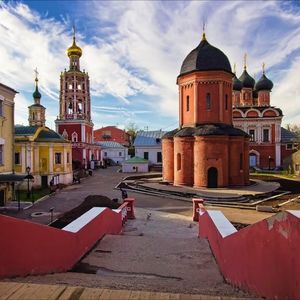Moscow monasteries
Besides the world-famous Novodevichy Convent (a UNESCO World Heritage site), there are many unique monasteries in Moscow, many of which lie in the city center (Novodevichy, coincidentally, is one of the furthest from downtown Moscow). Because, historically, the Moscow monasteries were less subject to reconstruction or redevelopments, they are able to preserve medieval culture and some of the oldest architectural feats in the entire city. Some of them still hold services: the Vysoko-Petrovsky, Donskoy, Danilovsky, Novospassky, and the Marfo-Mariinsky Convent. Others are no longer active, like the Andronikov and Bogoyavlensky monasteries, but are still incredibly culturally important.
As a rule of thumb, most tourists to Moscow visit only the Novodevichy Convent, as it’s listed in every guidebook.
We are trying to enrich and expand the experiences of our travelers in this area, and, fortunately, there are some great options. The Marfo-Mariinsky, or Martha and Mary, Convent is unique in its relative modernity of architecture and design. The Vysoko-Petrovsky, which commands a hill just 1.5 kilometers from the Kremlin, is a unique example of the Naryshkin Baroque style of architecture. Groups of Old Believers preserving their special traditions and way of life are concentrated in the Moscow communities of Rogozhskaya and Preobrazhenskaya.
A visit to a Moscow monastery can be far more than just some stories about Orthodox saints and architecture. On our excursions, we might drink tea with the monks in a monastery’s refectory or meet with restorers to learn more about their work.
Below are some of Moscow’s most important monasteries.
High Monastery of Saint Peter (Vysokopetrovsky)
The High Monastery of Saint Peter ((Vysokopetrovsky Monastery) was founded in the 14th century, and is one of Moscow’s most ancient architectural ensembles.
The unusual form of the Church of Saint Peter is of particular interest, reminiscent of a flower with eight petals, and was built by the Italians that erected the Kremlin’s walls and cathedrals in the beginning of the 16th century.
During Soviet times, the monastery was looted and badly damaged, and different organizations made their home here, from a kindergarten to a factory workshop to a library.
Restoration work started in 1991 after the fall of the USSR, and the regular clergy only returned in 2009.
Novodevichy Convent guided tour
This monastery has, for the most part, preserved its original appearance, having been unscathed by the process of destruction that most Moscow monasteries saw in Soviet times.
his women’s monastery became a prison for many woman with tzarist lineage: Peter the Great locked up his sister, Sofia, here during a coup d’etat, and exiled or widowed tzarinas and princesses lived here.
The monastery is a full-fledged architectural ensemble, and contains the Cathedral of Our Lady of Smolensk, modeled after the Kremlin’s Cathedral of the Assumption. The unique Novodevichy Cemetery is located here, where most famous Russian figures are buried; a tour around Novodevichy Cemetery is yet another engrossing tale.
Novodevichy Cemetery
The best place in the city to look for its unparalleled history is the Novodevichy Cemetery.
General Secretary Nikita Khrushchev, the wife of Mikhail Gorbachev, Raisa Maksimovna, the first president of the Russian Federation Boris Yeltsin, Stalin's wife Nadezhda Alliluyeva, and other prominent figures from the 20th century, from Anton Chekhov to composer Dmitri Shostakovich, are buried here.


















